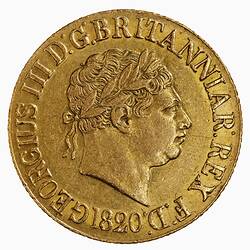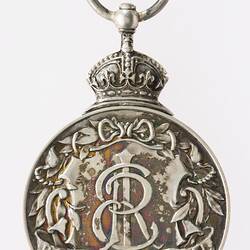Summary
Victory Medal 1914-1919 with ring mount and ribbon awarded to Pte. Thomas Joseph Hewitt, service number 1937, 57th Infantry Battalion - 2 to 5 Reinforcements (April-September 1916), A.I.F.
Thomas Joseph Hewitt was a 23-year-old linotype operator when he joined in March 1916 in Melbourne to fight in World War I. He embarked on 8 July 1916 on the HMAT Ajana. By December he was in France, and on 23 December was taken on strength in the 58th Battalion. On 12 May 1917, the 58th Battalion was in the Hindenberg Line during the Battle of Bullecourt (3-17 May 1917). The Unit Diary reported 'Enemy heavies shelling area in rear of our lines...numerous casualties occured...fierce hand to hand fighting with rifle and bombs...[after 4.30pm] sector was again vigorously shelled for two hours...During the twenty-four hours the trenches were greatly destroyed. Almost all the posts were blown out...' Special stretcher parties were requested to clear the wounded, which they completed by midnight. Hewitt received a shell wound to head that caused a compound fracture of his skull, and paralysis to his right leg. He was sent to England and admitted to the National Hospital on 23 May, and remained there until 12 September, when he was transferred to hospital in Dartford. His doctor was Dr Farenridge, an Australian. Hewitt was sent back to Australia on 31 October 1917, and spent time recovering in the Caulfield Military Hospital. He was discharged on 2 February 1918 on the grounds of being medically unfit. He lived to the age of 91 years.
The Victory Medal was authorised in 1919 and was awarded to army, navy and air force personnel who served in a theatre of war between midnight 4th-5th August 1914 and midnight 11th-12th November 1918. The Allies resolved that, if they wished to issue a Victory Medal, it would share a common feature of a depiction of Victory on the obverse and a ribbon of red, yellow, green, blue and violet merged into a rainbow pattern. This medal, that of Great Britain, was awarded to personnel from countries in the British Empire (some 5,725,000 were issued). The other Allied countries that issued Victory medals were: Belgium, Brazil, Cuba, Czechoslovakia, France, Greece, Italy, Japan, Portugal, Romania, Thailand, Union of South Africa and the United States of America.
Museum Victoria holds two photographs of Hewitt in hospital as well as several personal effects.
Obverse Description
Figure of Victory facing three-quarters right with wings spread; in her right hand she holds a palm branch, her left hand is extended and open. The artist's initials, W.McM. (W. McMillan) are above the ground line on the right.
Reverse Description
The words, 'THE GREAT . WAR FOR . CIVILISATION 1914-1919' within a circular wreath of laurel.
Edge Description
Text; '1937 PTE. T.J. HEWITT. 58 BN. A.I.F.'.
More Information
-
Collection Names
-
Collecting Areas
-
Acquisition Information
Donation & Subsequent Transfer from Victorian Branch, Returned & Services League of Australia Limited (RSL), Miss A. Casey, 24 Feb 1986
-
Issued By
-
Mint
-
Artist
-
Awarded To
Private Thomas J. Hewitt, Australia, 1919
1937 Pte T.J. Hewitt. 58th Battalion, A.I.F. -
Inscriptions
Obverse; 'W.McM.' (W. McMillan- artist). Reverse; 'THE GREAT . WAR FOR . CIVILISATION 1914 - 1919'. Edge; '1937 PTE. T.J. HEWITT. 58 BN. A.I.F.'.
-
Material
Bronze
-
Axis
12
-
Classification
-
Category
-
Discipline
-
Type of item
-
Overall Dimensions
50 mm (Height), 36 mm (Outside Diameter)
Height to top of loop.
-
Shape
Round with loop and ribbon
-
References
References: [Link 1] Battalion Unit Diary, Australian War Memorial HEWITT Thomas Joseph, barcode 5481826, series B2455, National Archives of Australia
[Book] Joslin, E C., et al. 1988. British Battles and Medals., 230 - 1 Pages
-
Keywords











